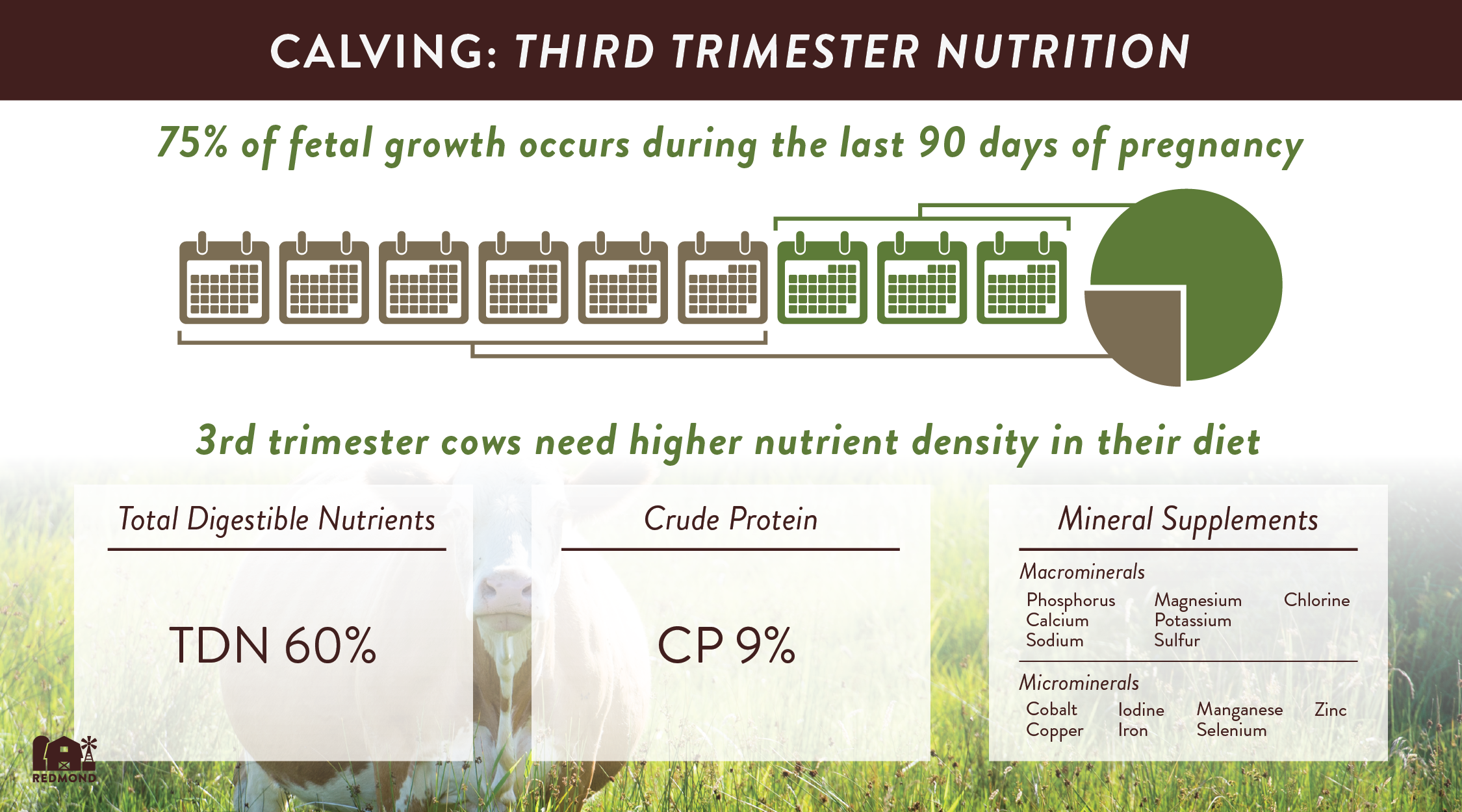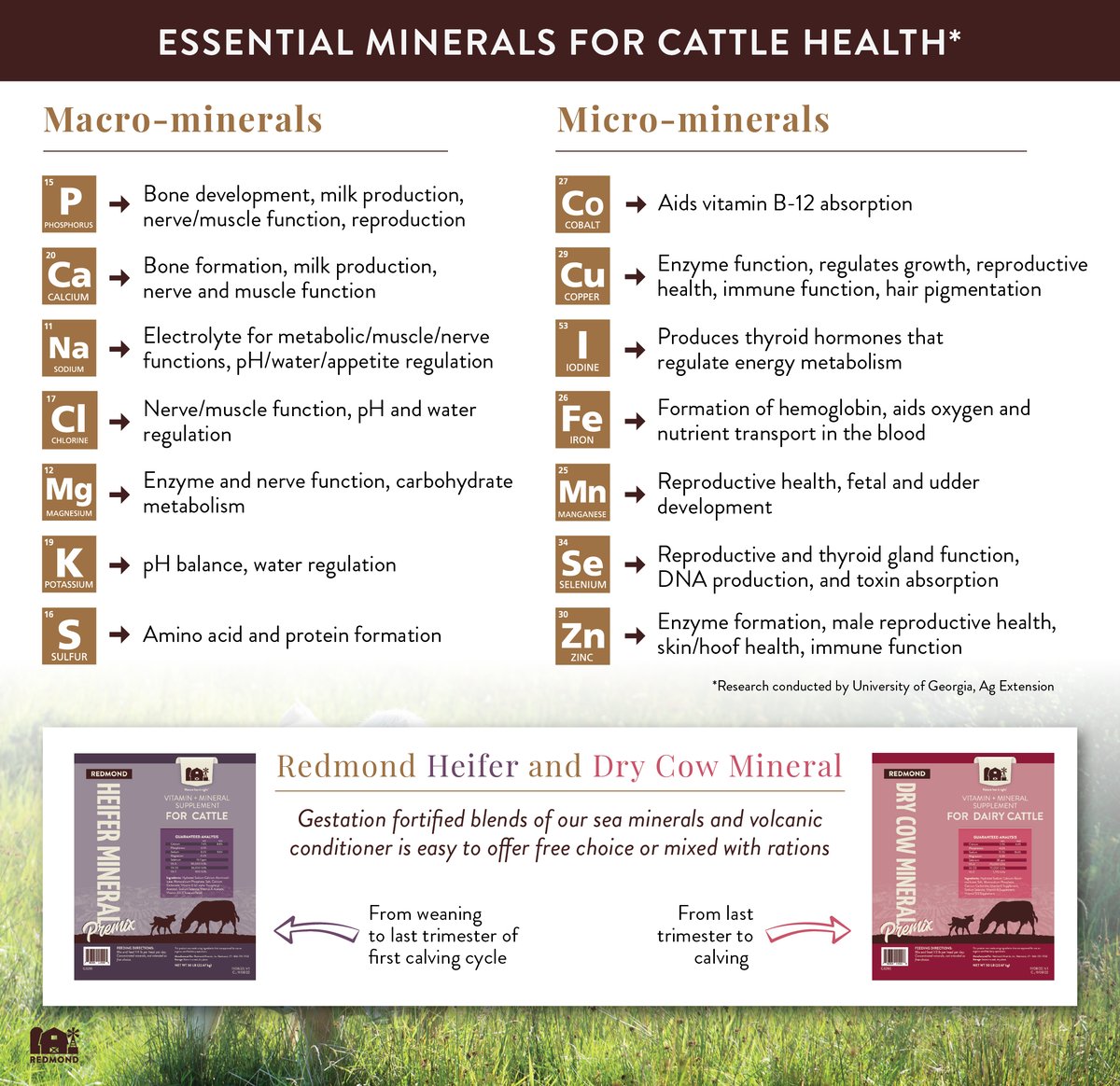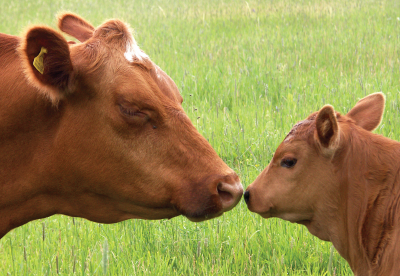Fetal Programming
After World War II, scientists began noticing that malnourishment during human pregnancy had a negative impact on both the mother and baby's health for many years to come. Over the decades, those studies have led to many positive changes in prenatal health that have had a lasting impact for all of us.
In the last several years, scientists have been applying those same principles to cattle health and in a practice called fetal programming. They have discovered that undernourished cows:
- Have trouble finishing labor
- Have weaker immune systems
- Pass on deficiencies and health problems to their calves
- Struggle to produce adequate milk after birth...and more
The University of Nebraska-Lincoln (UNL) Institute of Agriculture and Natural Resources said:
“recent research has shown maternal nutrition during late gestation can have lasting impacts on calf health, growth, and performance postnatally. These impacts can include improved weaning weights, yearling weights, and marbling scores of progeny.”
• Learn more from UNL’s in depth-research on fetal programming.
So how do we help gestating cows avoid these health problems, and produce a healthier and more productive next generation? Let’s start by looking at your calving calendar.
Calving Calendar
Not every cattle operation uses the same calving schedule. Make a note of what time of year your cows will enter their final trimester. If your schedule plans for calves in the spring, your cows will be in their 3rd trimester during the winter time. Remember that weather stress can lower a cow’s body condition score (BCS). That means, if their 3rd trimester aligns with harsher weather, you will need to build an adequate nutrition program and conduct BCS in the fall to ensure they get a healthy start to their last trimester.
Third Trimester Nutrition Needs
Now let’s take a look at the nutritional categories that can help your herd during the 3rd trimester. Remember that not every cow will have the same nutritional requirements. It is very important to use BCS when building a 3rd trimester nutrition program. Some cattle operations even separate cows, and group them by BCS to make sure the right nutrition is being given to the right cows. Overall, nutrient, protein, and mineral content should ramp up during the last 90 days before calving.

Total Digestible Nutrients
Having your feed and forage tested for total digestible nutrients (TDN) is both crucial and affordable. In fact some local ag extension programs will even perform this testing for free if you properly collect your samples. Be sure to submit samples to a National Forage Testing Association (NFTA) certified lab to get the most accurate results.
Testing your forage and feed will give you a better idea of how much digestible fiber, proteins, lipids, and carbohydrates are in your cow’s diet. Higher TDN values mean a healthier colony of ruminal microbes in your cows’ digestive system. And healthy ruminal colonies mean nutrients and energy are being properly shared between the cow and the developing fetus.
According to Beef Magazine, cattle nutritionists recommend the following TDN levels for the prenatal and postnatal stages:
- Mid-pregnancy: 55% TDN
- Late pregnancy: 60% TDN
- After calving: 65% TDN
A Note About Winter
Forage TDN values can decrease during the winter, so you may need to submit samples for testing multiple times a year. For this reason, some operations use nutritional supplements during the winter to help their cattle maintain a healthy BCS.
Crude Protein
Gestating cows are hard at work building and assimilating an entire new body of tissues, so it makes sense that they need increased levels of protein. When eaten, crude protein (CP) is divided into 2 portions:
- Rumen Degradable Protein (RDP): dietary protein that feeds the microbes in the rumen (sometimes known as microbial crude protein or MCP)
- Rumen Undegradable Protein (RUP): dietary protein that escapes the rumen and enters the intestines to be digested and absorbed.
Beef Magazine also states that cattle nutritionists recommend the following CP levels for the prenatal and postnatal stages:
- Mid-pregnancy: 7% CP
- Late pregnancy: 9%CP
- After calving: 11-12% CP
Trace Minerals
According to The University of Georgia Ag Extension, the following macro and microminerals are essential for cattle health:

Macrominerals
- Phosphorus- bone formation, milk production, nerve and muscle function, reproductive maturation
- Calcium- bone formation, milk production, nerve and muscle function
- Sodium- electrolyte for nerve and muscle function, pH regulation, water and appetite regulation, weight maintenance
- Chlorine- nerve and muscle function, pH regulation and water regulation
- Magnesium- enzyme and nerve function, carbohydrate metabolism
- Potassium- pH balance, water regulation
- Sulfur- amino acid and protein formation
Microminerals
- Cobalt- aids vitamin B-12 absorption
- Copper- enzyme function, regulates growth, reproductive health, immune function, hair pigmentation
- Iodine- thyroid/hormone/metabolism regulation
- Iron- formation of hemoglobin to deliver oxygen and nutrients in the blood
- Manganese- reproductive health, fetal and udder development
- Selenium- reproductive and thyroid gland function, DNA production, toxin absorption
- Zinc- enzyme formation, male reproductive health, skin and hoof health, immune function
Supplementing trace minerals during the last trimester is extremely beneficial for mother and calf, even if they do not test as mineral deficient. Reinaldo Cooke, PhD, at Oregon State University, conducted a study on the effects of organic trace mineral supplements during the 3rd trimester.
The Oregon Study
A herd of 84 pregnant cows, all sired by the same bull, were divided during their last trimester. Before the study, the entire herd was tested to show no mineral deficiencies and their feed rations were identical and tested. During their last trimester, trace mineral supplements were given, except to the control group.
The Results
- Weaning weight: calves from the organic trace mineral group had a $70 per head advantage over the control group calves.
- BRD treatments for respiratory illness: 42% of control group calves needed BRD, but only 20% of the organic trace mineral calves needed BRD
- Average finishing weights: control group (1,428 lbs), organic trace mineral group (1,496 lbs)
Last Trimester Nutrition: How Can Redmond Help?
Increase Forage TDN
Any operation that grass feeds or grass finishes their cows can enjoy the benefits of conditioning their soil with trace minerals. Plants need more than just the typical Nitrogen/Phosphorus/Potassium fertilizer in order to give grazing animals whole and complete mineral health. Multiple studies have proven that applying Redmond Minerals greatly increases brix scores and TDN values in a wide range of forage grains (corn, hay, grass, alfalfa, etc).
- Learn more about how Redmond's soil program can increase the nutrients in your forage and how that results in higher profitability for cattle operations.
Improve Animal Health and Boost Productivity
For both beef and dairy operations, starting your cows on a trace mineral supplement will be the easiest and best decision you can make for your cattle...especially your pregnant cows! Our supplements contain over 60 naturally occurring trace minerals that animals love. Our cattle mineral solutions will save you money over your current mineral program, produce healthier animals, and can be customized to your herd’s exact nutrition needs.
Take a look at these testimonials and see how Redmond Minerals has helped these customers and their herds:
Give us a call today at  to learn more about how Redmond Minerals can improve rumen health, boost herd immunity, increase reproduction rates, improve animal weight, boost milk production, and nourish happier and healthier cows.
to learn more about how Redmond Minerals can improve rumen health, boost herd immunity, increase reproduction rates, improve animal weight, boost milk production, and nourish happier and healthier cows.
© 2024 Redmond Minerals Inc.

